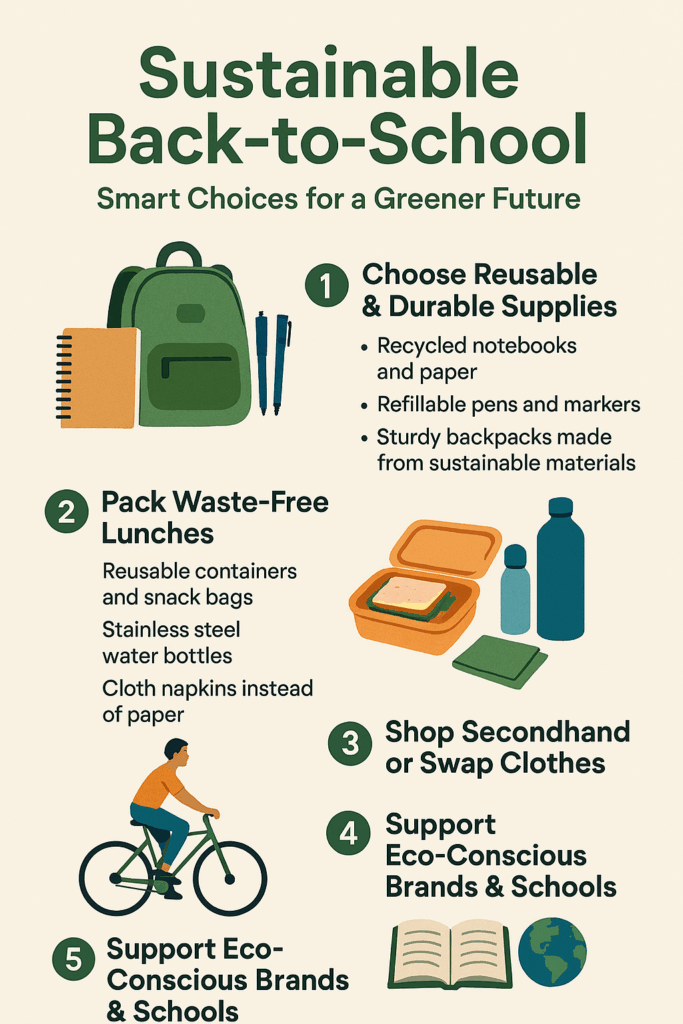As the school year approaches, families gear up for the annual back-to-school rush—often marked by shopping sprees, packed lunches, and new supplies. But this season also brings a surge in waste, much of which can be avoided with a few mindful choices.
Sustainability isn’t just a buzzword—it’s a way to teach kids responsibility, reduce environmental impact, and even save money. Let’s explore how you can make this school year more eco-friendly, backed by eye-opening statistics.
The Waste Problem: By the Numbers
- Public schools in the U.S. generate over 14,500 tons of waste every day, much of it from single-use plastics like utensils, straws, and bags 1.
- Each student using disposable lunch gear produces about 67 pounds of waste per school year.
- School food waste totals approximately 530,000 tons annually, costing up to $9.7 million per day to manage.
- College students generate an average of 640 pounds of solid waste per year, including packaging, electronics, and clothing.
- A single college cohort can produce 430,000 plastic bottles annually.
These numbers highlight the urgent need for sustainable practices in schools—from elementary classrooms to college campuses. Now, as you prepare to send the kids off to another school year, take a moment to review these tips and see what you can do to help eliminate waste.

1. Choose Reusable & Durable Supplies
Who doesn’t have a stash of pens, notebooks and folders that pile up each year when school lets out & the kids clean out their desks and lockers? Instead of buying new every year, reuse what you can. When purchasing new items, look for:
- Recycled paper products
- Refillable pens and markers
- Backpacks made from sustainable materials
2. Pack Waste-Free Lunches
School lunches are a BIG opportunity to make an impact. Nowadays, everything is conveniently packaged in individual servings, making them ideal for families on the go. But with a little advance planning, you can help minimize waste AND save yourselves some money. Yes, those single-serves are convenient, but the cost/unit goes way up! Reduce single-use plastics with:
- Reusable containers and snack bags
- Stainless steel water bottles
- Cloth napkins and washable utensils
Bonus: It’s healthier and more cost-effective!
3. Shop Secondhand or Swap Clothes
Fashion is one of the leading culprits of waste. Seasons change and so do styles and before you know it, that top that was once the “it” thing to wear is now sadly out of style, ending up either in landfill or donation box. Kids grow fast—so why not:
- Visit thrift stores or online resale platforms
- Organize clothing swaps
- Support brands with ethical and sustainable practices
Thrifting is now “cool” again. Styles that were popular 20 years ago are now back in. Thrifting is a great way to allow kids to display their personalities and show off their own personal style, with a lower cost to your bank account AND the planet.
4. Green Your Commute
Walking, biking, or carpooling reduces emissions and promotes wellness. Schools can also encourage safe routes and bike racks.
5. Advocate for Greener Schools
You may think you don’t have a say in how our schools operate, but many times they are understaffed, over-worked, and open to parent input & participation. Taking an active role at your kids’ school doesn’t just have to focus on academics. You can help build practices that will truly make lasting impacts. Encourage your school to:
- Implement recycling and composting programs
- Replace Styrofoam trays with compostable alternatives
- Conduct waste audits to identify areas for improvement
6. Teach Sustainability at Home
Yes, school is where kids go to learn, but the reality is that they are just sponges, picking up behaviors and knowledge around every corner. While they may learn their math & writing skills at school, they are learning life skills 24/7. Be a good role model & ambassador for the environment. Reinforce eco-friendly habits like:
- Turning off unused electronics
- Reducing water waste
- Composting and recycling properly
Final Thoughts
Back-to-school doesn’t have to mean back to waste. By making small, intentional choices, families and schools can reduce their environmental footprint and set a powerful example for future generations.
Let’s make this school year smarter—and greener.